| Hepatitis B is one of the most important liver diseases. It is known as the third worldwide transmitted disease and the 9th cause of worldwide mortality [1]. People with hepatitis B infection are considerably at risk of liver cirrhosis and hepatocellular carcinoma (HCC) which are of important health problems in the world [1,2]. There are more than 350 – 400 million carries of hepatitis B virus in the world [1, 3]. Approximately 75% of hepatitis B carriers are living in Asian countries [4]. Iran is considered as a country with average HBV prevalence that about 2 – 3% of Iranians is HBsAg positive [5, 6]. About 1.4 million people in Iran are infected with Hepatitis B Virus (HBV) [1]. |
| Disobedience of preventive behaviors by pre-marriage women will increase the prevalence of hepatitis B among women and therefore it plays an important role in neonates' morbidity and the prevalence of hepatitis B in the next generation. Having more information about the pre-marriage women health beliefs about hepatitis B vaccination, would be beneficial to plan and perform proper interventions and consequently to decrease hepatitis B prevalence. There are some theories to manage behavior and affecting factors which are purposed to identify factors associated with healthy and risky behaviors and ultimately designing effective educational programs [1]. As for hepatitis B is a behavioral problem, it is better to be evaluated using health educational theories. Health belief model [HBM] is one of the applicable models in health education to identify preventive behaviors and associated factors [1, 7]. Based on this model, the first step to follow preventive behaviors is that people feel the issue susceptibility (perceived susceptible). Then they should perceive the issue side effects on physical, emotional, social and economic aspects of their life (perceived severity), believe that prevention is possible and beneficial (perceived benefits), and be aware that prevention benefits are more useful and more economical than barriers (perceived barriers). Perceive that they would be able to follow the preventive behaviors in spite of many problems and barriers (self-efficacy) and finally follow the preventive behaviors [3]. |
Objectives
|
| To our knowledge, no studies have been done to evaluate related factors of hepatitis B vaccination in pre-marriage women using HBM. Considering this issue and with regard to the important role of HBV prevention in the family health, we conduct this study to achieve new findings which could be effective in the mothers HB vaccination. |
Patients and Methods
|
| This cross-sectional study was performed in Karaj, IR Iran. There are two centers in this city which pre-marriage couples refer to follow up pre-marriage urinary and blood tests as well as contributing in pre-marriage counseling classes. Based on Iran vaccination program, neonates who were born before 1993 were not vaccinated routinely against hepatitis B. Hence, all pre-marriage women who were older than 22 years old at the time of study and referred to these two centers from April 2015 to May 2015 were eligible to enter to this study by random. These individuals should be literate, should not be infected with HBV, should not be vaccinated against hepatitis B previously and should not contribute in hepatitis B educational programs prior to the time of study. Results of our pilot study on 35 pre-marriage women showed that the mean score of perceived severity was 3.64 ± 0.85. Therefore, based on the following formula where d=0.2 and considering 95% statistical power of the study, 70 premarriage women with included criteria were randomized to our study. |
 |
| The progress of case selection is shown in Figure 1. To do this, firstly we prepared a list of all eligible individuals, secondly we assigned a code to each person, and finally the subjects were selected by random. |
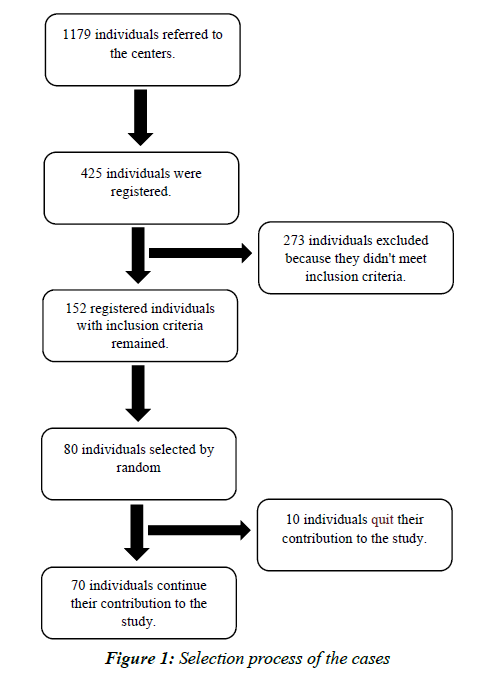 |
| Before entering the study, all participants were justified about the purpose of study and information confidentiality. The participants were entered to the study voluntarily and they were explained that they could quite their contribution to the study whenever they were tended. Informed consents were completed and signed by the participants who volunteered to enter to the study. To gather data based on HBM constructs, we used a questionnaire which was made by researcher. Firstly, we designed the questionnaire using scientific literatures and library sources. Then, to strengthen the HBM constructs, we had an interview with people similar to those in our study. Faced validity of the questionnaire using impact score technic, content validity of the questionnaire using content validity rate (CVR) and content validity index (CVI) were applied to complete the questionnaire validity stages. To do this, the first draft of questionnaire containing 27 questions was provided to ten specialists in the field of health education, nursing, psychology, statistics, and infectious diseases. They were asked to specify if each question is essential and useful or not. Based on the Lawshe's CVR, 0.62 was the critical value for our questionnaire. So, we have revised three questions and we asked specialists to send us their comments again. Finally all questions could pass this step. |
| Besides, to assess CVI, we asked the experts to determine the questions simplicity, clarity, relevancy and specificity. The CVI score higher than 0.79 was considered adequate. In this step, three questions were revised and then we resend the questionnaire to the experts. Ultimately, all questions could achieve the adequate score for CVI. For the face validity of the questionnaire, we asked ten people with similar characteristics of the target group to determine the importance of each question. The impact score higher than 1.5 was considered acceptable. In this step all questions could achieve the critical value. In addition, the questionnaire passed the reliability stage using coder-richardson, test-retest, and Cronbach's alpha. To perform the test-retest stage, ten people with similar characteristics of the target group were asked to answer the questionnaire. After two weeks, we asked them to answer to the same questions again. Then we calculated correlations of their answers in this period of time. P<0.05 was considered significant. All questions could pass this step successfully. Furthermore, Cronbach's alpha was assessed to find out the items consistency. Cronbach's alpha value for all questions was more than 0.7 which were in the acceptable range. Finally, coder-richardson was applied for the knowledge questions with the score of 0.799 which was acceptable as well. |
| The questionnaires were completed by the participants, as self-reported questionnaire and covered following sections: |
| 1) Demographic characteristics including age, level of education, occupation, salary (4 questions) |
| 2) Knowledge (10 questions, i.e. "If a person is infected with hepatitis B can transmit the disease to others ") |
| 3) HBM constructs which was consisted of: A) perceived susceptibility (3 questions, i.e. "There is the risk of hepatitis B for me."); B) perceived severity (3 questions, i.e. " Hepatitis B infection can be fatal."); C) perceived benefits (3 questions, i.e. "Hepatitis B vaccination will lead to my health."); D) perceived barriers (5 questions, i.e. "I don’t have enough time for hepatitis B vaccination."); E) self-efficacy (2 questions, i.e. "I can follow up hepatitis B vaccination, in spite of heaving a lot of problems.") |
| 4) Health behavior (1 questions, "Have you done hepatitis B vaccination in the past two months ") |
| 5) Behavioral intention of hepatitis B vaccination (1 questions, "I will do hepatitis B vaccination in the next two months."). |
| Two trained investigators were cooperated to conduct the study and collect the data. We considered about 15 minutes for each participant to complete the questionnaire. |
Data Analyses
|
| Completing the questionnaire by the participants, data were analyzed using SPSS version 21. |
| Pearson correlation coefficient was used to find out correlation between data with normal distribution and Spearman correlation coefficient was applied to achieve the correlation between data which are not distributed normally. Moreover, independent t-test and chi-square were used to evaluate participants’ demographic characteristics as well as their mean score of knowledge, and health beliefs in two different groups according to their intention of hepatitis B vaccination. All data distributed normally in each group. P<0.05 was considered statistically significant. We also used descriptive statistics (such as frequency, percentage, mean, standard deviation) to analyze the data. |
Results
|
Socio-demographic characteristics
|
| There were 70 participants aged 23–43 year old (mean ± SD=29.63 ± 3.857). About 54.3% of the participants were 28 – 32 years old and the majority of the participants were under graduated (47.1%). Fifty percent of participants were housewives while 50% were employed among which monthly income of most of them were below $330 (82.9%). Complete demographic characteristics of the participants are described in Table 1. Also, Table 1 shows relationship between participants’ demographic characteristics with their intention of hepatitis B vaccination. Considering two groups of participants based on their intention of hepatitis B vaccination, no significant relationship was found between these variables (Table 1). |
| Furthermore, the participants' mean ± SD score of knowledge and health beliefs are illustrated in Tables 2. In accordance with Table 2, participants achieved the highest score in perceived benefits (4.25 ± 0.715), while their score in perceived susceptibility (3.13 ± 0.568) was less than other constructs. Besides, Table 2 shows that there was a significant difference between participants’ mean score of perceived susceptibility (P=0.034) and self-efficacy (P=0.003) in two groups with positive and negative intention of hepatitis B vaccination. Also total mean score of HBM was significantly different in participants' intention of hepatitis B vaccination (P=0.003) |
| With respect to participants’ intention of hepatitis B vaccination, only 32.9% stated that they are going to do hepatitis B vaccination over next two months (Figure 2). Interestingly, in center 2 (Fardis) a greater percentage of pre-marriage women said that they are intended of hepatitis B vaccination over next two months. |
Participants’ knowledge, health beliefs, and behavioral intention
|
| The effect of participants’ socio-demographic characteristics on their knowledge, health beliefs and behavioral intention of hepatitis B vaccination were assessed by correlation coefficient. Even though, there wasn’t any significant correlation between the participants’ socio-demographic characteristics with their knowledge, health beliefs and behavioral intention of hepatitis B vaccination. |
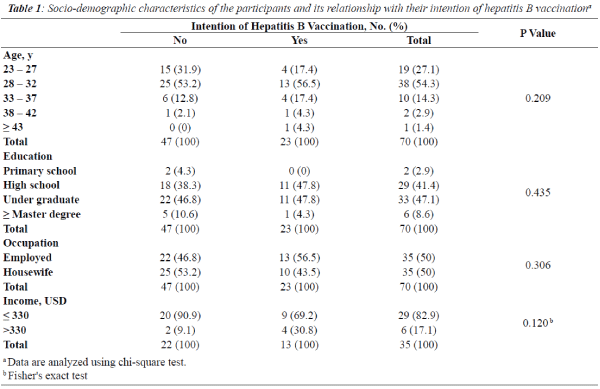 |
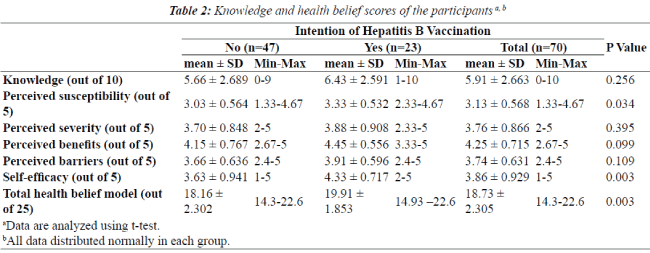 |
| We also assessed correlation between knowledge, health belief constructs and the participants’ intention of hepatitis B vaccination using Pearson and Spearman correlation coefficient. In respect to Table 3, there was a significant and direct correlation between perceived severity and perceived benefits (P<0.001, r=0.551). In addition, significant and direct correlations were found between the participants’ knowledge with their perceived severity (P=0.001, r=0.395), perceived benefits (P=0.006, r=0.327) and self-efficacy (P=0.004, r=0.343). Similarly, we found significant and direct correlations between perceived severity (P<0.001, r=0.420), perceived benefit (P=0.001, r=0.398), and perceived barriers (P<0.001, r=0.440) with the participants’ self-efficacy. Along those lines, the participants’ self-efficacy (P<0.001) and perceived barriers (P=0.037) were significantly related with their intention of hepatitis B vaccination, nevertheless; the correlation coefficient between these variables were 0.476 and 0.249 respectively. |
Discussion
|
| We have conducted a descriptive-analytical study in which we described the status of knowledge, health beliefs, and behavioral intention of hepatitis B vaccination among premarriage women. |
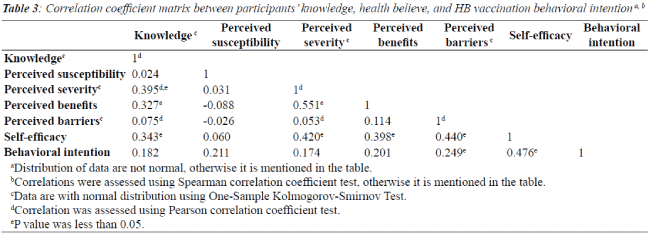 |
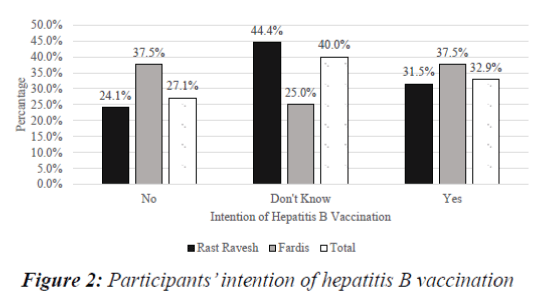 |
| To better classification of results and based on the same studies, we categorized total score of each construct as bellow: 70–100 was considered good score, 60–70 was moderate, 50–60 was not in an acceptable range and below 50 was considered poor [3]. |
| Based on the results of our study, pre-marriage women could achieve 59.1% of total score of knowledge, which was not in an acceptable level. This issue highlights the necessity of education for this group of society to increase their knowledge. In agreement with our results, other studies reported similar findings in other groups of society. For instance, a study by Jokhio et al., revealed that only 36.6% of the barbers in Hyderabad have enough knowledge about hepatitis transmission [8]. Furthermore, in another study by Kabir et al., knowledge level of Iranian medical specialists was moderate to low [9]. Robotin et al., conducted an interventional study to assess hepatitis B knowledge of primary care providers. The mean knowledge score of participants before intervention was 63% of total score [10]. In contrast, some other studies such as the study conducted by Dehghani Tafti et al. and Lu et al. showed good knowledge of the participants [3, 11]. |
| In our study, participants achieved 62.6% of total score in perceived susceptibility (26.66%-93.33%), 75.2% in perceived severity (40%-100%), 85% in perceived benefits (53.33%-100%), 74.8% in perceived barriers (48%-100%), and 77.2% in self-efficacy (0%-100%). These findings suggest that perceived susceptibility of the participants was moderate, while their levels in other constructs were good. Likewise to our study, perceived benefits in both Dehghani Tafti et al. [3] and Yazdani et al. [1] study were good. While Dehghani Tafti et al., showed differently in other constructs [3]. In their study perceived susceptibility of the participants was acceptable, whereas perceived severity and perceived barriers of the participants in their study were moderate and poor respectively. Finally, in contrast to our study, the students’ self-efficacy to hepatitis B prevention behaviors in Yazdani et al., study was low. These differences might be related to various factors such as level of education, type of career or number of participants, etc. |
| In addition, in another study entitled "Knowledge, beliefs and preventive behaviors regarding Influenza A in students: a test of the health belief model", Najimi et al., showed that the students perceived susceptibility, perceived benefits, and self-efficacy about Influenza were good, that’s’ while their perceived severity and perceived barriers were moderate [12]. These data shows that only in perceived benefits and self-efficacy our finding were compatible with Najimi et al., that might be affected by the type of diseases. |
| The highest mean score of our participants was related to their perceived benefits and the lowest mean score belonged to perceived susceptibility; nonetheless, in Yazdani et al., study perceived barriers and self-efficacy had the highest and the lowest mean scores, respectively [1]. |
| The results of a study by Zamani Alaviche et al., showed that perceived susceptibility is the most important construct to predict behavioral intention of hepatitis B vaccination [13]. In our study, there was a significant difference between mean score of individuals’ perceived susceptibility in two groups with positive and negative intention of hepatitis B vaccination (P=0.034). Also, Zamani Alaviche et al., revealed that perceived benefits and self-efficacy are in the next stages of predicting hepatitis B vaccination behavioral intention. The differences between mean scores of individuals’ self-efficacy was significant in our study as well (P=0.003) while we couldn’t find this difference between their perceived benefits and behavioral intention of hepatitis B vaccination. These results are in favor of positive effect of self-efficacy and perceived susceptibility with intention of hepatitis B vaccination. |
| In the study conducted by Dehghani Tafti et al., direct correlation between participants’ knowledge with their perceived susceptibility (P<0.001, r=0.498) was revealed [3]. That’s while in our study this relationship was not significant (P=0.842, r=0.024). By contrast, we found a direct correlation between participants’ knowledge with their perceived severity (P=0.001, r=0.395), perceived benefits (P=0.006, r=0.327) and self-efficacy (P=0.004, r=0.343). Furthermore, contrastingly to our study, Dehghani Tafti et al., found a significant statistical correlation between the individuals’ level of education with their knowledge, perceived susceptibility, perceived benefits, and cues to action. It is noteworthy, correlation between participants level of education with their knowledge was confirmed in another study by Roushan et al. [4]. This difference might be related to our study sample size. Thus, further studies with more samples are recommended. |
| Additionally, Yazdani et al. found a significant correlation between participants intention of hepatitis B vaccination with their perceived susceptibility (P<0.001, r=0.279), perceived benefits (P=0.001, r=0.107), and perceived barriers (P<0.001, r=0.189) [1]. While in our study a significant correlation was found between participants’ intention of hepatitis B vaccination with their self-efficacy (P<0.001, r=0.476) and perceived barriers (P<0.037, r=0.249). Also both of us couldn't find any significant correlation between participants’ intention of hepatitis B vaccination with their perceived severity and age [1]. The same as our study, Lu et al. found out perceived barriers as the most important predictor of hepatitis B screening in Taiwan [11]. |
| In Yazdani et al., study about two third of students considered hepatitis B vaccination is not affordable [1]. These data are in contrast with our findings. In our study, only 12.9% of the individuals believed that hepatitis B vaccination is costly, 15.7% considered it a time consuming process and 11.4% believed that it is painful. In spite of correlation between intention of hepatitis B vaccination and perceived barriers, these data would warn us that perceived barriers could be obstacles to intention of hepatitis B vaccination. |
| With regard to the significant correlation between selfefficacy and intention of hepatitis B vaccination in our study and in respect to the significant correlation between self-efficacy and desired health behaviors in other studies conducted by Yazdani et al. [1] and Mazloomi et al. [14], we conclude that providing the bases of health education to increase self-efficacy in a society in order to train hepatitis B preventive behaviors, could be beneficial to promote public health in different groups of society. |
| In the end, in our study, 45.7% of the individuals declared they are at low or very low risk of hepatitis B. These findings are in accordance with Yazdani et al. study in which more than a third of students believed that they won’t be affected by hepatitis B virus [1]. Additionally, Hajian-Tilaki et al., performed a study in 2014 to evaluate breast self-examination and breast cancer screening in Iranian women using HBM [15]. Our results also confirm the findings of Hajian-Tilaki et al. study [15]. |
| In regard to HBM, the probability of performing an action by an individual for his own health depends on his understanding of the susceptibility and severity of the disease as well as his perceived benefits on the prevention of the disease against his perceived barriers. In addition, according to HBM, self-efficacy is identified as an important determinant of health behavior [16]. Due to this assumption and since women’s health can directly affect family members’ health, it is essential to improve pre-marriage women’s lack of perceived susceptibility to hepatitis B by holding several educational programs. Therefore, the results of this study could be useful to hold further interventions, in order to promote hepatitis B preventive behaviors, reduce the incidence of this disease and ultimately, promote the health status of the society. Consequently, it is recommended that holding educational programs to focus on pre-marriage women’s knowledge and health beliefs could be beneficial to improve their behavioral intention of hepatitis B vaccination. By the way more studies might be required with more sample size to support our findings. Moreover, for further studies we suggest a meta-analysis by researchers. |
Strength points
|
| - To our knowledge, it is the first time that the correlates of intention to hepatitis B vaccination in pre-marriage women is evaluated using the HBM |
| - Results of this study could be lead to the health of both women and their children |
| - Measuring the individuals knowledge and intention of hepatitis B vaccination besides the HBM constructs |
Limitations
|
| - Few number of participants |
| - Inequality of the number of participants in two centers |
| - The study was conducted only among women. |
Suggestions for further studies
|
| - We suggest researchers to complete this study using "cues to action" construct. |
| - Using an educational intervention could be beneficial for further studies. |
Ethical statement
|
| The study was reviewed and approved by the ethics committee of Alborz University of Medical Sciences. |
Acknowledgment
|
| We would like to express our warm appreciation to all colleagues in the two centers who assisted us to conduct the study. |
Funding/Support
|
| This article is supported by both Alborz University of Medical Sciences and Iran Hepatitis Network. |
|
|
References
- Yazdani R, Zamani-Alavijeh F, Kheiriat M, Shafiee A, Arjmandzadegan M. Factors associated with preventive behaviors of hepatitis B among high school girls using the health belief model. Daneshvar Medicine 2013;20:1-12.
- Taylor VM, Bastani R, Burke N, Talbot J, Sos C, Liu Q. Evaluation of a hepatitis B lay health worker intervention for Cambodian Americans. Journal of community health 2013;38:546-553.
- DehghaniTafti A, Farzaneh Z, Morowatishaifabad M, Mohammadloo A, Mirzaei Alavijeh M. Beliefs of Health Sector Personnel in Taft District about Hepatitis B: An Application of Health Belief Model. Tolooebehdasht 2014;13:145-156.
- Roushan N, Nasiri Toosi M, Meysamie A, Esteghamati AR, Hajrassuliha H. Hepatitis B knowledge among Iranian adolescents: a national survey. Iranian Red Crescent medical journal 2013; 15:e11558.
- Salehi M, Alavian SM, Tabatabaei SV, Izadi S, Sanei Moghaddam E, Amini Kafi-Abad S. Seroepidemiology of HBV infection in South-East of iran; a population based study. Iranian Red Crescent medical journal. 2012;14:283-288.
- Alavian SM, Tabatabaei SV, Nourizad S, Mansouri F, Khademi N, Kafi-abad SA. Seroepidemiology of HBV Infection in Kermanshah-West of Iran; a Population Based Study. Jundishapur Journal of Microbiology. 2012;5:564-569.
- Rahnavard Z, Mohammadi M, Rajabi F, Zolfaghari M. Effect of education based on health belief model on preventive behaviors of smoking in adolescents girls. Hyat 2011;17:15-26.
- Jokhio AH, Bhatti TA, Memon S. Knowledge, attitudes and practices of barbers about hepatitis B and C transmission in Hyderabad, Pakistan. Eastern Mediterranean health journal = La revue de sante de la Mediterranee orientale = al-Majallah al-sihhiyah li-sharq al-mutawassit. 2010;16:1079-1084.
- Kabir A, Tabatabaei SV, Khaleghi S, Agah S, Faghihi Kashani AH, Moghimi M. Knowledge, attitudes and practice of Iranian medical specialists regarding hepatitis B and C. Hepat Mon 2010;10:176-182.
- Robotin M, Patton Y, George J. Getting it right: the impact of a continuing medical education program on hepatitis B knowledge of Australian primary care providers. International journal of general medicine. 2013; 6:115- 122.
- Lu SW, Dai ML. The impact of hepatitis B knowledge on screening behavior factors in outpatients. Hu li za zhi The journal of nursing 2013;60:51-63.
- Najimi A, Golshiri P. Knowledge, beliefs and preventive behaviors regarding Influenza A in students: a test of the health belief model. Journal of education and health promotion 2013;2:23.
- Zamani-Alavijeh F, Shafiei A, Ghofranipour F, Arjomandzadegan M. Effect of behavioral health belief model application on prevention of hepatitis B infection in teen girls. Payesh. 2012;11:545-554.
- Mazloomy S, Mirzaei A, Afkhami Ardakani M, Baghiani Moghadam M, Fallahzadeh H. The Role of Health Beliefs in Preventive Behaviors of Individuals at High- Risk of Type2 Diabetes Mellitus. The Journal of Shahid Sadoughi University of Medical Sciences. 2010;18:24-31.
- Hajian-Tilaki K, Auladi S. Health belief model and practice of breast self-examination and breast cancer screening in Iranian women. Breast cancer 2014;21:429-434.
- Glanz K, Rimer BK, Viswanath K. Health Behavior and Health Education: Theory, Research, and Practice. 4th ed. New York: John Wiley & Sons 2008
|





